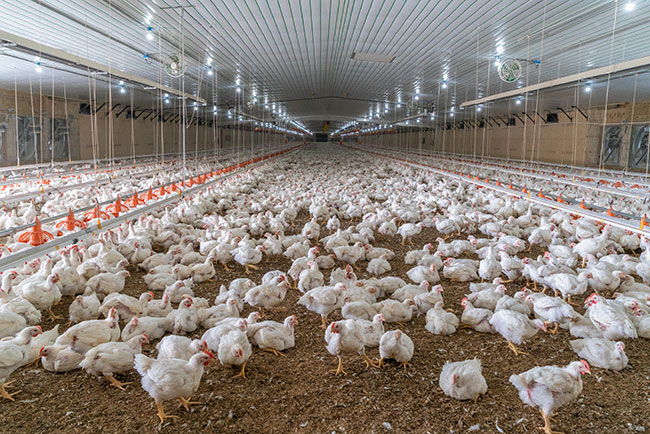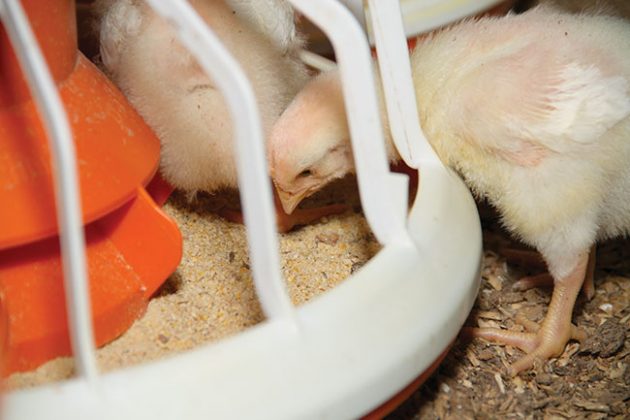
Ask the Vet: Air quality and poultry health
By Dr. Luke Nickel
Features Ask the Vet Ask the Vet VentilationHow does the air quality in my barn affect the health of my flocks?
 Adequate ventilation will play an important role in maintaining dry litter and subsequent ammonia production.
Adequate ventilation will play an important role in maintaining dry litter and subsequent ammonia production.
Photo: Big Dutchman
Adequate ventilation will play an important role in maintaining dry litter and subsequent ammonia production.
Adequate ventilation will play an important role in maintaining dry litter and subsequent ammonia production.
Photo: Big Dutchman The air quality within a poultry barn needs close attention to help achieve optimal poultry production results. It is one of the most important areas for a poultry producer to manage.
Although most modern poultry barns have full computer integration, which controls the exchange of air, producers need to make small adjustments to respond to continually fluctuating weather and environmental conditions.
Most poultry farmers in the world do not face the climate extremes that Canadian poultry producers face in both summer and winter. If the bird is housed in an unfavourable environment that is not achieving high quality air metrics it will lead to increased mortality, condemns and poor growth.
Some of the metrics to consider in providing good air quality include: Ammonia levels; dust; relative humidity; carbon dioxide; and air temperature.
The mucociliary escalator within the bird’s trachea is one of its first defences against respiratory challenges. The cilia are small hairlike structures that cover the inside of the trachea along its whole length. The cilia move in a coordinated motion to expel harmful bacteria, viruses and other dust particles that become stuck in the mucous secretions of the trachea.
For this physiological process to work effectively, it is reliant on integrity of the tracheal lining and proper mucous secretions. Any damage to the cilia or ability of the cells to secrete mucous will limit the ability of the bird to clear harmful particles from the respiratory tract. It will also allow bacteria and viruses a greater opportunity to cause damage to the bird.
Ammonia
One of the most common causes of damage to the mucociliary escalator is exposure to high levels of ammonia (20 to 25 parts per million [ppm]). Ammonia is a normal by-product of poultry production. Protein consumption in a bird’s diet leads to uric acid deposition, which is eventually converted to ammonia. Some of the factors that will increase ammonia production within the litter include pH, temperature, moisture, feed ingredients, relative humidity and ventilation.
If the level of ammonia production within the barn becomes too high it will cause ciliostasis (paralysis of the cilia) or even deciliation within the trachea. This process will lead to trapped particles (bacteria, viruses and dust) that cannot be adequately removed from the bird’s respiratory system and end up deeper in the lungs and air-sacs.
Adequate ventilation will play an important role in maintaining dry litter and subsequent ammonia production. During the winter months it can become even more challenging to control litter conditions. But spending the necessary money on heating will outweigh poor litter quality and potential respiratory health challenges.
Ammonia levels below 20 ppm can be difficult for the human nose to detect. Gas detectors and strips are available to help measure ammonia levels and aid in guiding ventilation decisions.
It is important when taking these measurements to be at the level of the bird and consider the ventilation system. To get an accurate picture of the levels in the barn, experts suggest taking the reading in the morning (before max ventilation output) and prior to all the fans turning back on.

Chicks that are chilled will have delayed gut development, impaired immune systems and stunted growth. Chicks that are chilled will have delayed gut development, impaired immune systems and stunted growth. Chicks that are chilled will have delayed gut development, impaired immune systems and stunted growth.
Relative humidity
Another key component of air quality is relative humidity. For optimal results, experts recommend keeping relative humidity (RH) between 50 to 70 per cent. If the environment is above 70 per cent for an extended period it will cause the litter to pick up increased moisture.
Once the litter starts to move in this direction It can be very difficult to correct. With the added moisture, the litter will also start to generate increased ammonia, which can lead to respiratory health issues mentioned earlier. The added moisture will also lead to increased growth of harmful bacteria, viruses, fungi and coccidial organisms as they prefer to grow and replicate in these environments.
We can also have problems if the RH falls below 50 per cent, particularly during brooding. Dewpoint is the temperature at which air can no longer hold all its water vapour and provides a more accurate reading on the effective “feels like” temperature for poultry.
Brooding at 90°F with 40 per cent RH is a significantly different environment than 9°F with 60 per cent RH. Chicks are hatched in an environment that is consistently at 70 to 80 per cent humidity and then delivered to the farm. If the farm is brooding at below 50 per cent RH it can lead to dehydrating the young chicks and potentially chilling. Birds that are chilled will have delayed gut development, impaired immune systems and stunted growth.
The easiest way to measure humidity is by having a meter in each barn or floor. It is best practice to have these installed at the level of the feed-pans to get an accurate reading each day. If the RH is above 70 per cent experts suggest increasing the run time of fans or adding another stage to the curve.
If the RH is below 50 per cent experts suggest moving to minimum ventilation and decreasing the run time of the fans if you are on a set timer.
Barn temperature
Another important factor to consider is the air temperature within the barn. The air temperature in the barn should be consistent during the day and evening, with the goal of minimizing large fluctuations.
Again, air temperature needs to be measured at the bird height and calibrated properly to ensure consistency.
It is important to acknowledge the value of maintaining good air quality in your poultry barn. After all, it will have a tremendous effect on the health and performance of your flocks!
The primary author of this article is Dr. Luke Nickel of Poultry Health Services, which offers a brooding program that includes guidance around creating an optimal barn environment for your flocks. Send questions for the Ask the Vet column to poultry@annexweb.com.
Print this page